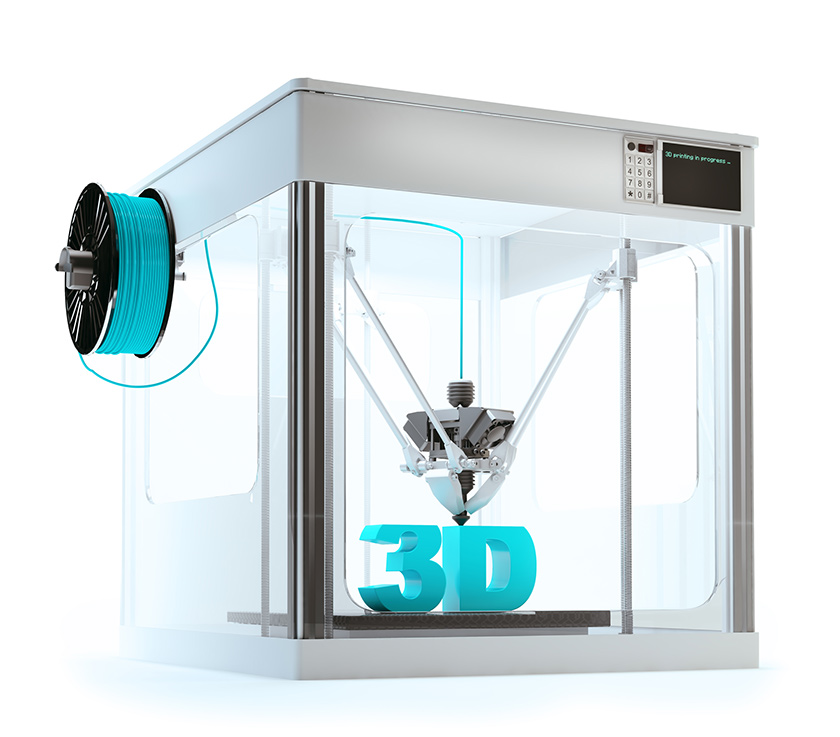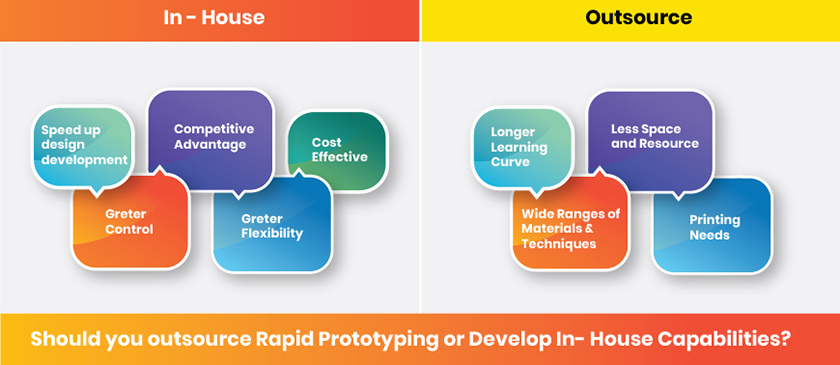Rapid prototyping is a cost-effective way to show a basic end product while reducing your risk on innovation projects. It’s the process of quickly mocking up key components of a system or physical part and validating it with users, customers, and stakeholders helping to bring the final product to market faster. Rapid Prototyping and innovation go hand in hand and can really give a business the edge from its competitors.
For those involved in product development and engineering, rapid prototyping technology can offer an excellent deliverable for various applications. Prototyping can be used for concept generation, ergonomic testing, test fitting, functional testing, and even small-batch production.

Rapid Prototyping Technologies
There are various rapid prototyping technologies available for use including; Fused Deposition Modeling (FDM), Stereolithography (STL), Selective Laser Sintering (SLS), and 3D Printing. Each of these technologies has its advantages and disadvantages.
Fused Deposition Modeling
FDM works on an “additive” principle by placing the material in layers. A plastic filament or metal wire is unwound from a coil and supplies material to an extrusion nozzle which can turn on and off the flow. The nozzle is heated to melt the material and can be moved in both horizontal and vertical directions controlled by a CAD software package. FDM is very quick, affordable, and has the ability to create complex geometries and structures. The cons include low resolution, as well as potential smoothing process to diminish layer lines.
Distinctive Features:
- Build material is usually supplied in filament form, but in some cases, plastic pellets fed from a hopper are utilized instead.
- Materials used include thermoplastics such as ABS, Polycarbonates, polyphenylsulfones, and Elastomers.
- Applications for FDM include form/fit testing, functional testing, rapid tooling patterns, small detailed parts, presentation models, patient and food applications, and high heat applications.
Industries Using FDM:
FDM is used primarily in the mainstream manufacturing industry. FDM is extremely popular with companies in the automotive (BMW, Hyundai, Lamborghini) and consumer goods manufacturing industries (Black and Decker, Dial, Nestle). All of these companies make use of FDM all the way through their product development, prototyping, and manufacturing processes.
Because the thermoplastics used most often in FDM can endure heat, chemicals, and mechanical stress, they are the ideal material for printing prototypes designed to withstand testing. Additionally, FDM can print highly detailed objects, which is why it is often used by engineers who need to test parts for fit and form.
Selective Laser Sintering
SLS uses a high-power laser to fuse small particles of plastic, metal, ceramic, or glass powders into a 3D object. The laser selectively fuses powdered material by scanning cross-sections generated from a 3D digital description of the part on the surface of a powder bed. After each cross-section is scanned, the powder bed is lowered by one layer thickness, a new layer of material is applied on top, and the process is repeated until completed. SLS is good for multiple pieces of small sized items with complicated geometry. Its cons include that it is not suitable for large flat parts as well as its running costs were high due to safety precautions. For example, the room that the SLS machine is used in must be separated from the powder-handling room to prevent explosions.
Distinctive Features:
- Powdered polymer and metal composite materials are transformed into successive cross-sections of a three-dimensional part.
- Materials used include nylon, glass-filled nylon, SOMOS (rubber-like), Truform (investment casting), and metal composites.
- Applications for SLS include form/fit testing, functional testing, rapid tooling patterns, less detailed parts, parts with snap-fits & living hinges, and high heat applications.
Industries Using Selective Laser Sintering:
SLS is used often in the healthcare, medial, and dental industries to develop anatomical models including dummies, training aids, and pre-operative planning models. Aerospace and automotive industries benefit from SLS in the form of parts manufacturing utilizing a variety of different materials. Tooling production (including jigs, fixtures, and a variety of other tools) in engineering-related industries also benefits from the rapid prototyping procedures afforded by SLS.
Stereolithography
SLA is a process utilizing a vat of liquid UV-curable resin and a UV laser to build parts a layer at a time. On each layer, the laser beam traces a part cross-section pattern on the surface of the liquid resin. Exposure to the UV laser light cures, or, solidifies the pattern traced on the resin and adheres it to the layer below. SLA is one of the most precise 3D printing techniques on the market and is popular because it’s print services are smooth. Cons include a longer printing time and higher costs.
Distinctive Features:
- Stereolithography is most often used for prototypes, large concept models, master patterns, and investment casting patterns.
- SLA makes use of photopolymers in liquid form. The main materials used are thermoplastics (elastomers).
- Applications for SLA include functional testing, form/fit testing, snap fits, highly detailed parts, rapid tooling patterns, high heat applications, and presentation models.
Industries Using Stereolithography:
This additive manufacturing process is popular in the medical industry, where (since 1990) it has been used to create accurate 3D anatomical models of patients’ body parts, based computer scans. The popularity of stereolithography 3D produced parts in automotive and wind tunnel testing is also on the rise, due to the highly accurate nature of the prototypes produced.
3D Printing
This unique form of prototype creation is rooted in traditional rapid printing technology. A three-dimensional object is created by layering and connecting successive cross sections of material. 3D printers are generally faster, more affordable, and easier to use than other additive fabrication technologies.
3D CAD prototyping offers tremendous potential for retail consumer uses, especially because the cost of production is less than other methods, and the part build time is minimal. In the latest incarnation, 3D color printing is also available. The only real cons are that the 3D printing can be limited in material selection, as not every metal or plastic can be temperature controlled enough yet for printing.
Distinctive Features:
- No special tools are required in 3D printing (for example, a cutting tool with certain geometry or a mold). Parts are manufactured directly onto a built platform one layer at a time.
- The list of materials used in 3D printing grows longer by the day. While plastic may reign supreme, materials like metal, graphite and graphene, carbon fiber, resin, Polylactic Acid, and High Impact Polystyrene are quickly catching up.
- Applications of 3D printing include rapid prototyping, architectural scale models, maquettes, movie props, and 3D printed prosthetics.
Industries Using 3D Printing:
3D printing is used most commonly in the aerospace, automotive, and consumer products industries to design and build prototypes, models, end-use parts, and tooling. This type of additive manufacturing process is also widely used throughout the architecture, engineering, and construction industries to develop models. The medical industry also makes use of 3D printing for their bioprinting processes.
Case Studies: Rapid Prototyping in Action
Below are two examples of well-known companies that use rapid prototyping to better their outputs and increase productivity.
Fender Transforms a Two-Week Lead Time into an Overnight Process
Fender is an American Manufacturer of amplifiers and string instruments, known all over the world for its famous Stratocaster used by musicians like Eric Clapton and Jimi Hendrix. Previously, the company was using an external service prototyping instrument parts. As the company grew, a lead-time of two weeks was no longer viable. To overcome this lag in production, and to be able to address the mounting pile of orders, Fender decided to tackle the task in-house.
The solution to their problem was to purchase their own industrial 3D printers which enabled them to design and print their own instrument parts; like new knobs on their amplifiers, for example. 3D printing one cubic inch of material costs around $4, which would be an enormous cost saving. With their previous outsourcing model, they had to pay additional labor and development costs to an external team.
Ford Saves Millions of Dollars and Months of Lead Time
Ford’s biggest challenge used to be months of lead-time when developing new prototypes. What used to take months is now achievable within a few hours with rapid prototyping. Prototypes, whether they are metal or plastic, can be developed within a day, enabling Ford’s teams to decide whether or not a specific part is worth the effort.
Recently, Ford used rapid prototyping technology on their new GT. A series of prototypes were used to refine and perfect their new F1-style steering wheel. Some additional lightweight structural components were also developed to cut down the weight of the car’s unique upward-swinging doors. Without rapid prototyping, the development of this new vehicle would have taken months, if not years.
In-house vs. Outsourced Prototyping
As part of the innovation process, if companies can afford it, they may employ rapid prototyping technologies in-house. However, many firms can make use of outsourced service bureau experts to provide their rapid prototyping needs.
Outsourced service bureaus can assist a business with tooling, industrial design, molding, and production. Service bureaus tend to specialize in one or more areas such as injection molding, casting, etc. It is advisable to examine a company’s portfolio or case histories on their web pages or discuss previous projects with the company to try to better understand areas of particular expertise.

If you are wondering if you should outsource your Rapid Prototyping process, let Data Entry Outsourced help you make that decision. Prototype outsourcing is extremely cost-efficient and sharing your prototypes with a product development team allows for the addition of many more ideas, hypotheses, and tests for your project.
Outsourcing teams move fast. When you have a team of multiple people with knowledge and expertise working on and testing the project instead of you and your in-house team alone, it only makes sense that the project will get done faster.
ICW’s professional rapid prototyping team is well-versed in the creation of models that integrate complex shapes and surfaces. We carefully evaluate designs before building the required models, bringing innovation to every stage of the prototyping process. Our services are widely used in the Automotive, Aerospace, Naval, Consumer Products, and Medical industries.
Our rapid prototype services range from lending hourly support for CAD model development to 3D printing pricing for orders of any size or scope. Contact IndiaCADworks today, and we’ll take your rapid prototyping project to new heights.
– IndiaCADworks
IndiaCADworks



